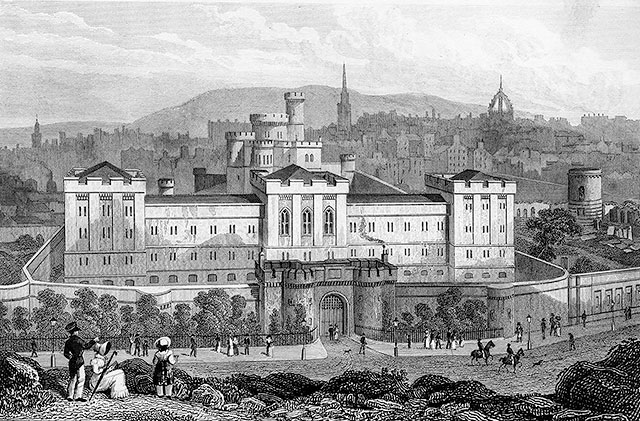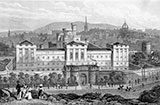|
Engraving from Modern Athens - published 1829 Calton Jail |
Looking from Calton Hill towards
Calton Jail and Arthur's Seat
with the Old Town of Edinburgh in the background
© Copyright: For permission to reproduce, please contact peter.stubbs@edinphoto.org.uk
|
Drawn by Thomas H Shepherd |
Engraved by W Tombleson |
|
Calton Jail |
|
Engraving Here is a view looking down from Calton Hill towards the Calton Jail. The jail is situated immediately to the left of the Bridewell. The Governor's House can be seen behind the jail. On the skyline, there can be seen the silhouettes of the Tron Kirk and St Giles church, both situated in the Royal Mile in the Old Town of Edinburgh. |
|
Construction of the Jail The foundation stone for the jail was laid in 1815. The book, Modern Athens, in which this engraving appeared gave a description of the jail: The building is surrounded by a massive wall, about twenty feet high; and is entered by an embattled gate, or lodge, which affords accommodation for the turnkeys; and has on the top a platform for the execution of criminals. |
|
Demolition of the Jail Following the construction of Saughton Prison in the western suburbs of Edinburgh in 1929, Calton Jail was demolished in 1930. This made way for the construction of St Andrew's House on the site, 1936-39. St Andrew's House consisted of government buildings to house the Scottish Office. |
|
Recollections 1. Rhoda Overson Greater London, England |
|
Thank you to Rhona Overson who wrote, asking: |
|
Engraving of Calton Jail "May I copy this image to my Ancestry Family Tree? My GGG Grandfather was imprisoned here in 1836 before being transported for life to Van Diemen’s Land. His crime was ‘forging and uttering’ a bill of exchange. It was his first offence and he had to leave behind in Newburgh, Fife, his wife and 8 daughters." Rhoda Overson, Greater London, England: 29 August 2016 |
|
Recollections 2. Rhoda Overson Greater London, England |
|
I told Rhoda that I was happy for her to use this image in her Ancestry Family Tree: I was sad to hear the fate of her GGG Grandfather, 180 years ago, and asked if she could tell me a little more about him. Thank you, Rhoda, for sending me the details below: |
|
Transportation to Australia Domestic Weaving "My GGG Grandfather, Thomas Hepburn, was born in Forgandenny, Perthshire in 1791. He was a weaver and sawyer in Newburgh, Fife. The domestic weaving industry i.e that carried out in the home, was going sharply into decline with the introduction of factory powerlooms." Forged Bill "I assume Thomas was beginning to feel the pinch especially with his burgeoning family of 8 daughters. So he forged a bill of exchange to the value of £68. I have seen a copy of it and it was a pretty poor attempt. He tried to pass the bill in a bank in Auchtermuchty but was caught." The Sentence "The crime of forgery relating to bills of exchange was a capital offence until the early 1830s. I think this was based on the fact that the British economy relied on this way of buying and selling goods. So Thomas was actually quite lucky. He could have been hung a few years earlier. Thomas compounded his offence, I believe, by lying to the Court (High Court of Justiciary in Edinburgh) and by bringing forth a witness who gave him a false alibi. He was sentenced to transportation across the seas for the rest of his natural life." Appeal "While he was in Calton Jail he got his solicitor to write to the Home Secretary asking him to commute his sentence, either by letting him serve a shorter sentence in Scotland or by allowing him to be accompanied by his wife and daughters, at no cost to himself. The Home Secretary turned down his appeal." Van Damien's Land "Thomas arrived in Van Diemen’s Land in December 1836. He obtained a Conditional Pardon around 1850 which gave him the freedom of Australia but forbade him to return to the UK. (This was normal practice for those transported for Life). " Life in Australia "I don’t know what became of him after that. He appears on the passenger lists of a couple of ships going from Hobart to Port Phillip (Melbourne) in the early 1850s but that is the last sighting I have of him. I know it was him because convicts were known by the ship that transported them to Australia. He was ‘Thomas Hepburn, Eden 1’ (‘1’ being the first voyage of the Eden). He was now in his 6th decade and I imagine he died during that decade, perhaps looking for gold in the Australian gold fields." Rhoda Overson, Greater London, England (since 1969): 30 August 2016 |
|
Engravings from Modern Athens - Published 1829 |
|||
|
Maps for Begbie photos |
|
|
Maps for photos: |
|
|
Maps for engravings: |
|
|
Photographs |
Around Edinburgh |


